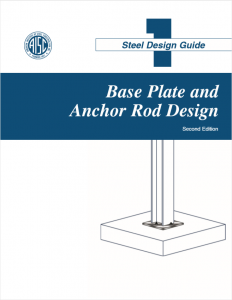
Figure 1: Book 1
Information presented on this page is intended to demonstrate the section design convergence of 2005 AISC Specification for Structural Steel Buildings provisions for Base Plate and Anchor Rod Design that can be achieved with SkyCiv. All examples are taken from the following references:
Book 1: James M. Fisher, Lawrence A. Kliober. Steel Design Guide 1. Base Plate and Anchor Rod Design (Second Edition), 2006.
The most significant results are compared in the table below:
Book 1 | Chapter 4.0 Design of Examples
| Results | ||||
|---|---|---|---|---|
| Examples | SkyCiv LFRD |
Manual LFRD |
skyCiv ASD |
Manual ASD |
| 1. Base Plate for Concentric Axial (No concrete confinement), t = | 1.61 | 1.60 | 1.47 | 1.54 |
| 2. Base Plate for Concentrix Axail Compressive Load | 1.49 | 1.50 | 1.49 | 1.50 |
| 3. Available Tensile Strength of a 3/4 in. Anchor Rod | 14.38 | 14.40 | 9.58 | 9.6 |
| 4. Concrete Embedment Strength | 19.4 | 19.5 | NA | NA |
| 5. Column Anchorage for Tensile Loads | ||||
| 6. Small Moment Base Plate Design | 1.35 | 1.36 | 1.39 | 1.39 |
| 7. Large Moment Base Plate Design | 1.90 | 1.90 | 1.82 | 1.82 |
| 8. Shear Transfer Using Bearing | 1.26 | 1.26 | 1.26 | 1.26 |
| 9. Shear Lug Design | ||||
| 10. Edge Distance for Shear | 32.7 | 32.7 | 32.7 | 32.7 |
| 11. Anchor Rod Resisting Combined Tension and Shear | 30.09 | 30.10 | 20.88 | 20.11 |
Book 1 | Appendix B
| Results | ||||
|---|---|---|---|---|
| Examples | skyCiv LFRD |
Manual ASD |
skyCiv LFRD |
Manual ASD |
| Triangular Pressure Distribution | ||||
Example # 1 Base Plate for Concentric Axial Compressive Load (No concrete confinement).
reference: Book 1, pp. 31.
DESCRIPTION
A W12x96 column bears on a 24-in x 24-in. concrete pedestal.
Determine the base plate dimensions and thickness for for the given required strength, using the assumption that A2 = A1 (Case I).
GEOMETRY AND MATERIAL PROPERTIES
Figure 2: Base Plate model and material properties of example #1
| Detail Inputs (Geometry) | ||||
|---|---|---|---|---|
| 1. Steel Column | d = 12.71 in | bf = 12.16 in | tw = 0.55 in | tf = 0.90 in |
| 2. Plate | N = 24 in | B = 24 in | ||
| 3. Column (Pedestal) | N2 = 24 in | B2 = 24 in | ||
LOADING
Two static loads cases are considered for LRFD and ASD:
| INPUT | LFRD | ASD |
|---|---|---|
| MANUAL | 700 kips | 430 kips |
| SKYCIV | 500 kips | 430 kips |
The results of service and factor load combination are in computed in reference of ASCE/SEI 7-10.
ANALYSIS
The analysis is done using the rigid conventional method. See the SkyCiv Base plate Manual for more explanation on using SkyCiv Base Plate.
RESULT COMPARISON
The most significant results are compared in the table below:
| Detail Results | ||||
|---|---|---|---|---|
| Examples | skyCiv LFRD |
Manual LFRD |
skyCiv ASD |
Manual ASD |
| 1. Required Base plate area | 421.57 in2 | 422.00 in2 | 421.57 in2 | 422.00 in2 |
| 2. inequality | 729.30 kips | 729.00 kips | 448.80 kips | 499.00 kips |
| 3. Base plate plate thickness | 1.61 in | 1.60 in | 1.47 in | 1.54 in |
Example # 2 Base Plate for Concentric Axial Compressive Load (Using concrete confinement).
reference: Book 1, pp. 32.
DESCRIPTION
A W12x96 column bears on a 24-in x 24-in. concrete pedestal.
Determine the base plate dimensions and thickness for for the given required strength, using the assumption that A1 ≤ A2 ≤ 4A1 (Case III).
GEOMETRY AND MATERIAL PROPERTIES
Figure 2: Base Plate model and material properties of example #1
| Detail Inputs (Geometry) | ||||
|---|---|---|---|---|
| 1. Steel Column | d = 12.71 in | bf = 12.16 in | tw = 0.55 in | tf = 0.90 in |
| 2. Plate | N = 16 in | B = 14 in | ||
| 3. Column (Pedestal) | N2 = 24 in | B2 = 21.6 in | ||
LOADING
Two static loads cases are considered for LRFD and ASD:
| INPUT | LFRD | ASD |
|---|---|---|
| MANUAL | 700 kips | 430 kips |
| SKYCIV | 500 kips | 430 kips |
The results of service and factor load combination are in computed in reference of ASCE/SEI 7-10.
ANALYSIS
The analysis is done using the rigid conventional method. See the SkyCiv Base plate Manual for more explanation on using SkyCiv Base Plate.
RESULT COMPARISON
The most significant results are compared in the table below:
| Detail Results | ||||
|---|---|---|---|---|
| Examples | skyCiv LFRD |
Manual LFRD |
skyCiv ASD |
Manual ASD |
| 1. Required Base plate area | 421.57 in2 | 211.00 in2 | 421.57 in2 | 211.00 in2 |
| 2. inequality | 729.30 kips | 716.00 kips | 448.80 kips | 400.00 kips |
| 3. Base plate plate thickness | 1.61 in | 1.50 in | 1.47 in | 1.50 in |
Example # 3 Available Tensile of 3/4-in Anchor Rod.
reference: Book 1, pp. 34.
DESCRIPTION
Computation the available tensile strength of a 3/4-in. diameter Anchor Rod using ASTM F1554 Grade 36.
GEOMETRY AND MATERIAL PROPERTIES
| INPUT | SKYCIV |
|---|---|
| Anchor rod code | ASTM F1554 Grade 36 |
| diameter | 3/4in dia. |
ANALYSIS
The analysis is done using the rigid conventional method. See the SkyCiv Base plate Manual for more explanation on using SkyCiv Base Plate.
RESULT COMPARISON
The most significant results are compared in the table below:
| Detail Results | ||||
|---|---|---|---|---|
| Examples | skyCiv LFRD |
Manual LFRD |
skyCiv ASD |
Manual ASD |
| Tensile Strength | 14.41 kips | 14.40 kips | 9.61 kips | 9.6 kips |
Example # 4 Concrete Embedment Strength
reference: Book 1, pp. 34.
DESCRIPTION
Calculating the tensile strength design of the concrete for a single smooth 3/4-in. diameter headed anchor rod with an embedment length of 6 in.
GEOMETRY AND MATERIAL PROPERTIES
| INPUT | SKYCIV |
|---|---|
| Concrete strength | 4000 psi |
| diameter | 3/4in dia. |
| hef | 6 in |
ANALYSIS
The analysis is done using the rigid conventional method. See the SkyCiv Base plate Manual for more explanation on using SkyCiv Base Plate.
RESULT COMPARISON
The most significant results are compared in the table below:
| Detail Results | ||||
|---|---|---|---|---|
| Examples | skyCiv LFRD |
Manual LFRD |
skyCiv ASD |
Manual ASD |
| Tensile Strength | 19.52 kips | 19.50 kips | N/A | |
Note: No equivalent ASD solution to this this check exist on ACI.
Albert Pamonag, M.Eng
Structural Engineer, Product Development


